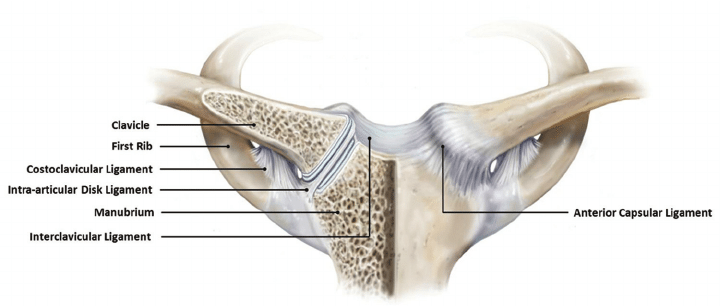ANATOMY:
The sternoclavicular joint is formed by the connection between the clavicle and the manubrium of the sternum. The joint plays an important role in arm movements as it is the only joint connecting the upper limb to the axial skeleton. Several ligaments and the subclavius muscle stabilises the joint.
CAUSE:
Injury to the sternoclavicular joint can occur due to trauma involving direct contact to the joint or a fall onto the side of the body resulting in forces being absorbed through the joint. During high impact contact dislocation or subluxation of the sternoclavicular joint may occur however this is less common than dislocation of the shoulder joint. Subluxation of the joint may result in longer term instability of the joint.
The sternoclavicular joint may also produce pain due to degenerative or inflammatory conditions which will often present as an onset of pain without trauma.
DIAGNOSIS:
Diagnosis of sternoclavicular pathology is based on several features including tenderness and swelling of the joint, a joint instability sensation and a reproduction of localised pain with arm abduction overhead or lying on the affected sided. Dislocations of the sternoclavicular joint may present with difficulties breathing and swallowing.
It is important other conditions are assessed including the presence of osteoarthritis, rheumatoid arthritis or fractures to the clavicle or sternum.
If pain of the sternoclavicular joint is due to trauma, X-ray investigations may be requested to assess for subluxation or fractures. Blood tests are utilised to assess for inflammatory conditions.
MANAGEMENT:
Subluxations and sprains of the sternoclavicular joint are often recommended to undergo conservative management including pain medication, a short period of immobilisation, modified activities involving non-contact sports and physiotherapy rehabilitation. Physiotherapy management may involve strengthening and motor control exercises of the shoulder and scapular muscles and manual therapy to the sternoclavicular joint and surrounding structures. If the sternoclavicular joint is dislocated or unstable surgical management is recommended.

